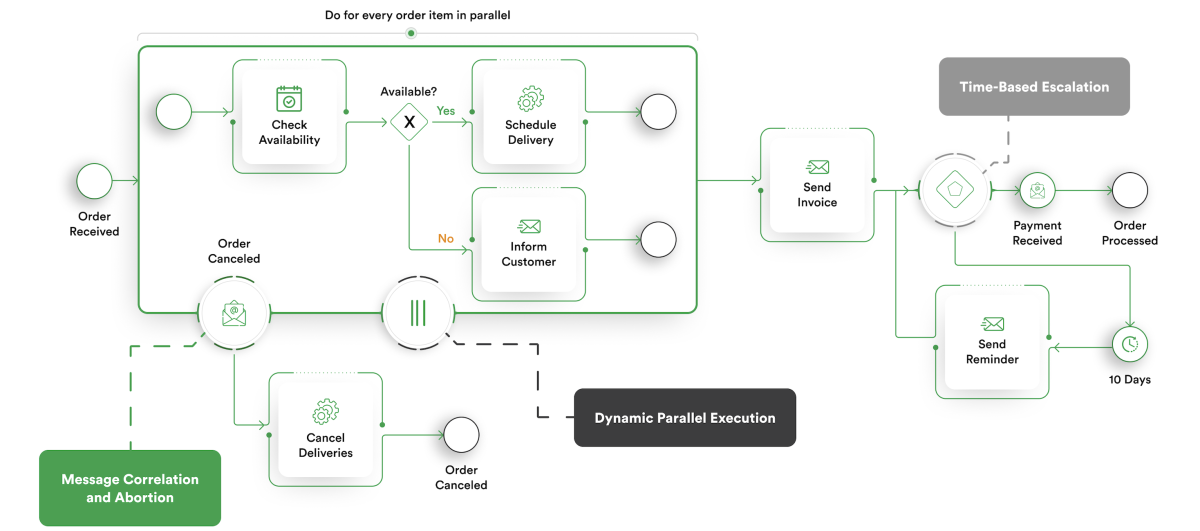It isn’t a challenge to understand the principles behind workflow orchestration. However, looking at examples to see how workflow orchestration can benefit organizations is important. This section spotlights four key examples of workflow orchestration: data pipelines, application deployment, IT process automation, and business process automation.
Data Pipelines
We all know that data is the primary asset of modern enterprises. That’s why the first and perhaps most important example of workflow orchestration involves data pipelines. Data pipelines are complex because data often comes in varying formats and from disparate sources. We can break down the typical data workflow into collection, storage, and analysis. Numerous other activities take place around these parent processes, all of which can be optimized by data workflow orchestration.
Data workflow orchestration via the introduction of automation technologies can provide numerous advantages, including fewer human errors, simplified workflows, empowered DevOps personnel, and high-quality and accurate data assets. Data workflow orchestration is vital because of the importance of big data analytics. Companies are reliant on large volumes of data to generate actionable business insights, deploy products and services, and outpace competitors. Data workflow orchestration can ensure that the quality, speed, and consistency of this critical data, metadata, and related processes are continuously upheld.
Application Deployment
Workflow orchestration for application deployment involves cohering, automating, and optimizing processes within software development lifecycles. The orchestration of application deployment encompasses several processes, including designing, testing, building, deploying, managing, and maintaining software. A plethora of workflow orchestration tools can be custom-built or commissioned to strengthen and streamline these critical application deployment workflows.
Workflow orchestration for application deployment is a prominent use case because of the prevalence of CI/CD (Continuous Integration/Continuous Deployment) pipelines. This is a software development methodology that is defined by speed and automation. The success of CI/CD pipelines, DevOps environments, and other agile workflows is dependent mainly on the quality and application of workflow orchestration tools.
IT Process Automation
Modern enterprises operate out of complex IT environments, often amalgamating IaaS and PaaS services and on-premises data centers. Companies are also embracing different kinds of operational methodologies and remote work models, all of which significantly complicate key IT processes. The limitations of legacy IT processes primarily involve the human factor. Despite our immense capabilities, humans are consistently the most fragile link in an enterprise’s IT architecture. Operational inefficiencies, security breaches, compliance mishaps, and convoluted workflows in IT environments that humans often create can be addressed by introducing workflow orchestration tools. These tools can replace human workers in certain IT processes and assist them in others.
IT process automation includes a range of important use cases, including automated backups, recovery, updates, patching, onboarding and offboarding employees, and resource management. The limitations of legacy infrastructure, which is often responsible for IT workflow lags and complexities, can also be addressed by integrating robust workflow orchestration tools. The bottom line is that IT processes are the backbone of every organization; therefore, it’s one of the most important areas to introduce workflow orchestration.
Business Process Automation
The last example of workflow orchestration we’re going to explore is business process automation. Business process automation involves replacing manual work with automated tools and mechanisms to perform daily business-specific tasks. Like other examples in this list, the advantages of business process automation include cost-efficiency, consistency, fewer errors, heightened visibility, streamlined collaboration, and tightened security and compliance posture.
Key business processes that can benefit from workflow orchestration tools include onboarding and offboarding employees, contracts and order processing, and a multitude of payment processes. According to McKinsey, 52% of survey respondents claim that intelligent document management is the most advanced automation use case. Forty-five percent responded that case management platforms were an advancing example of business process automation. More and more business processes will inevitably be orchestrated. But keep in mind that the road to successful workflow orchestration is rife with challenges. We will explore the most dangerous challenges in the next section.




